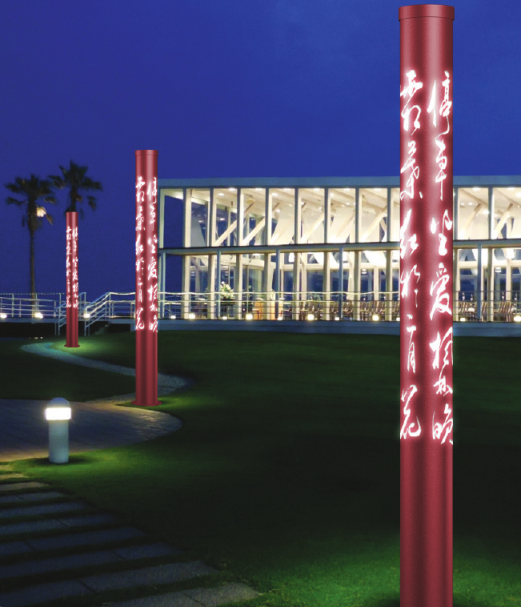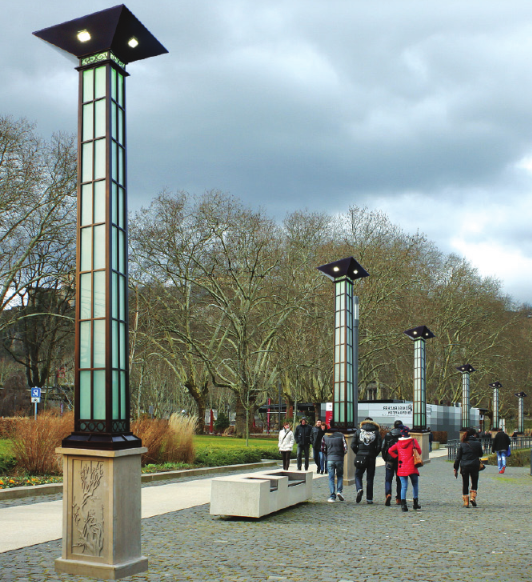LED product application range
LED not only retains three advantages, but also retains the advantages of small size, low driving voltage, adjustable black color, and good concentrating function. With the continuous improvement of LED luminous intensity, its application range is also expanding, and gradually enters the lighting category. Therefore, more and more units involved in the development and production of high-brightness and white-light LED products have been introduced. Many companies that have been LED packaging companies and consume lighting products have also entered. It is known that there are more than 1,000 companies nowadays. Development of lighting, special lighting and automotive lights.
In addition to the large number of international LED products used in the flashing of various electrical appliances and devices, instruments, equipment, non-mainstream collections have also advanced by leaps and bounds.
First, large, medium and small LED flash screen: indoor and outdoor billboards, stadium scoreboards, audio flash screens, etc.
The second is Traffic Lights: city traffic lights, highways, railways and airport signal lights in major and medium-sized cities across the country.
The third is light color lighting: outdoor landscape lighting and indoor cover lighting.
International LED packaging materials and accessories are also compatible. Except for ordinary materials, most of the materials are supplied domestically. Non-mainstream materials include gold wire, silicon aluminum wire, epoxy resin, silica gel, silver glue, conductive adhesive, bracket, strip and molding compound, packaging mold and fixture. Has formed a large-scale wealth chain.
About high power LED package use
High power LED electronic packages are complicated due to their structure and process. It has been a hot topic in recent years, especially the high-power white LED electronic package is a hot spot for research.
The choice of LED packaging methods, materials, structures and processes is not determined by factors such as electronic product chip structure, optoelectronic/mechanical characteristics, meticulous use and interest. After more than 40 years of development, the LED package has experienced the development of the bracket type (LampLED chip type (SMDLED power type LEDPowerLED).
As the power of the chip increases, the need for solid-state lighting technology is particularly demanding, and new higher demands are placed on the optical, thermal, electrical, and mechanical structures of the LED package. In order to effectively improve the light extraction efficiency, a new technical idea must be adopted to stop the packaging idea.
Forming white light. Its characteristics are non-mainstream including particle size, shape, luminous efficacy, conversion efficiency, shake (hot and chemical), etc., where luminous efficacy and conversion efficiency are critical. Studies have shown that as the temperature drops, the quantum efficiency of the phosphor increases, and the effect of the phosphor in the LED package lies in the color-composite. When the light is reduced, the wavelength of the radiation also changes, which causes the color temperature and chromaticity of the white LED to change, and the higher temperature accelerates the aging of the phosphor.
The reason is that the phosphor coating is prepared by epoxy or silica gel and phosphor, and the heat dissipation function is poor. When subjected to ultraviolet light or ultraviolet light, it is easy to burst temperature quenching and aging, and the luminous efficiency is increased. In addition, the thermal dynamics of potting and phosphors at ultra-low temperatures have also been achieved. Since the common phosphor size is above 17um, the refractive index is greater than or equal to 1.85 and the refractive index of the silica gel is generally at 1.5. Due to the mismatch of refractive index between the two, and the size of the phosphor particles is much larger than the light scattering limit (30 nm, there is light scattering on the surface of the phosphor particles, which increases the light extraction efficiency. By incorporating nano-phosphor in silica gel, The refractive index is increased to above 1.8, the light scattering is reduced, the LED light-emitting efficiency is improved (10%-20% and the light color quality can be effectively improved. The spot can be better treated, and the high-power product after packaging is added with the secondary lens. No yellow spots.
In 1996, Nichia's Nakamura et al. first used blue LEDs to link yellow phosphors to convert and decompose. The yellow phosphor used by him is Y3Al5O12:Ce3+ (referred to as YAG:Ce3+). This kind of phosphor has strong broadband recruitment in the 470nm band, and high-power LED packaging technology. Then stimulate the yellow light near 540 nm for power. The blue light emitted by the LED itself combines with the yellow light inspired by the phosphor to cause white light. Since then, YAG:Ce3+ has become a tributary technology for white light due to its high conversion efficiency, good thermal non-interference and wide excitation band.
Development of new phosphors
YAG: Ce3+ is one of the first phosphors commonly used in white LED technology, but because of its low emission color spectrum, I heard that it is a high-power led. It is difficult to obtain a white light with a high color rendering index and low color temperature. .
On the other hand, look at the high power LED lights. The continuous advancement of semiconductor lighting has led to the development of phosphors with higher conversion efficiencies. In the late stage, it was agreed to attend (Ca,Sr)S:Eu2+, (Ca,Sr)Ga2S4:Eu2+ red-green phosphors in YAG:Ce3+ to meet the high color rendering index and low color temperature, but due to such alkaline earth metal sulfides Physical and chemical properties are unstable, deliquescent, volatile and corrosive, and cannot meet the needs of the lighting industry.
Recently, a red phosphor with excellent thermal stability and chemical stability has been developed, which can completely replace alkaline earth metal sulfide to achieve a high color rendering index, low color temperature white LED, which has a silicon nitrogen (oxygen) tetrahedral structure. Known as nitrogen oxides, it has higher excitation efficiency. The trend in the development of power-type white LED packaging technology.
At present, foreign companies are technically naive in the use of phosphors for LEDs and hold important patents. Learn white light. They occupied the LED market by monopolizing the patents on phosphors. The YAG:Ce3+ phosphor patent was mainly occupied by Nichia [US], and Osram conquered the Tb3Al5O12:Ce3+ phosphor patent [US,,], TG, LWB and Tridonic Holding the patent [US] incorporating Eu2+(SrBaCa)2SiO4Si:Al,B,P,Ge, Intematix holds the patent of Eu2+(SrBaMg)2SiO4O:F, Cl, N,S [US,,].
In contrast, international research on LED phosphors is mostly concentrated in research institutes and technology development. Mainly for the research on the synthesis of existing phosphor data and physical properties such as luminescence, but not enough in the development of industrial technology.
Equipment and development of white LED optical model
Phosphors are used in white LEDs and are also subject to LED requirements. Such as the particle size of the phosphor, and the like. High-power LEDs. Research on phosphors has focused on the effects of the optical properties of phosphors on the functionality of white LED packages. For example, light extraction efficiency, face color distribution, and light color quality. In these studies, Monte Carlo ray tracing techniques use optical software to mimic the optical performance of LED package structures. I don't know high-power LED package technology. The phosphor layer tube is bundled into a Mie scattering material, so that the excitation and emission characteristics of the white LED can be obtained by optical simulation, but the simulation does not discuss the specific scattering characteristics of the phosphor, and lacks experimental research.
New phosphor coating method
The conservative phosphor coating method is in the form of powdered powder, that is, the mixture of phosphor and colloid is filled into the chip holder cup and then heated and solidified. Package. The amount of phosphor in this coating method is difficult to limit, and because of the different excitation light, the white LED easily exhibits a yellow spot, such as a blue spot, and the like.
Philips Lumileds has proposed a conformal coated phosphor coating method, led high power floodlights . They cover up a layer of phosphor film with the same thickness in the flip chip profile, in fact. The light color stability of white LEDs has been improved.
There are also companies that use a method of depositing a layer of phosphor on the surface of the chip to achieve excitation. These coating methods are all in contact with the phosphor. The optical simulation of H.Luo et al.'s final confession, the near-field excitation method of this phosphor-to-chip contact, and the development trend of power-type white LED packaging technology. The cost of backscattering filled with excitation light reduces the light extraction efficiency of the device.
Australia's Sommer used a numerical simulation to simulate Philips Lumileds' phosphor conformal coating structure. The results show that this coating method does not provide better angular uniformity. With the deep optical simulation of white LEDs, the plan for phosphor far-field excitation shows more advantages.
High current injection and heat dissipation structure
In order to meet the demand for high-light flux of general illumination, people have increased the driving power of a single chip. In the past, chips were injected into 3W high-power LEDs, 5W high-power LEDs, and even higher. This makes the thermal problem of white LEDs more and more tense. People use various heat dissipation technologies, such as heat pipes, micro heat pipes, water cooling, air cooling, etc. to dissipate the LEDs.
Landscape Lamp lighting is decorative light source configuration of city garden landscape,cultural and recreational square and large-scale social activities widely used and essential,is a decorative lighting products.Rod material diverse use of flexible,light,sound,light,electricity three-in-one,structure and morphology in different poses and with different expressions,beautify,lighting,green organic combination,light and shadow,perfect crystal lamp and art.


1. Decorative landscape lighting products.Design style or abstract avant-garde such as artistic sculpture, or simulation realism such as natural normal elements can beautify the lighting environment and become a symbol of the national culture in a city.Whether it is a large cultural square or a fashion building community, there is a reason for it.Excellent viewing and use value.
2. applicable place:Park, courtyard and upscale residential area, road side, commercial pedestrian street, leisure plaza, scenic tourist area, etc.
3. material description:Steel lamp body, the whole high quality hot dip galvanizing after electrostatic spraying, not rusting, aging, surface clean.The light source is metal halide lamp, energy-saving lamp and LED.
Landscape Lamp
Landscape Lamp,Landscape Lamp Post,Landscape Lampshade,Landscape Lamps
Jiangsu chengxu Electric Group Co., Ltd , http://www.chengxulighting.com